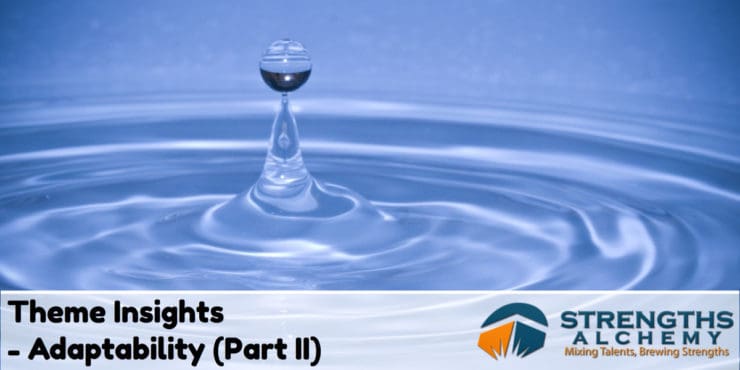
We learnt in a previous article that people with high Adaptability engage with change enthusiastically, and prefer to go with the flow. Their energies pool in the now and the present. As with any other talent theme, it can sometimes be perceived negatively. In this article, we look at some of these perceptions about Adaptability.
Raw and Mature Forms of Adaptability
In its raw form, Adaptability may seem like apathy, “I don’t care”, reactivity instead of proactivity. A mature form of that will be to readily accept and support new initiatives. Adaptability by itself only takes direction when responding to something; it will not decide on direction unless change happens, but is able to verbalise and mobilise people around change. It’s energized when change is thrown at it and don’t need as much time as others to be comfortable with change.
In its raw form, Adaptability may seem like neediness, wanting immediate responses in the present. A mature form of that will be sensing what everyone needs in the present moment before responding to what has already been said.
In its raw form, Adaptability may seem like a lack of stability, with no long-term plan. The idea of needing to plan is very short. However, a strengths conversation with Jerrick – a student with Adaptability – reveals that this doesn’t mean that they don’t plan. Rather, maturity entails planning to anticipate and change. Planning for the immediate present is quickly accomplished, instead of for the rest of the week.
Transforming Adaptability into a Strength
If you’re working closely with, or even parenting, someone with Adaptability, you may have struggled to appreciate its raw forms, especially if you have Achiever, Activator, or Focus. How can parents or supervisors harness the talents and potential of Adaptability for positive strength transformation?
- Find a role where they’re needed for how they react quickly. Set up ways that they can be relied on for what others – or you – need right now.
- Give them tasks where they have enough autonomy to get from start to finish quickly, where they don’t need to stop and ask for guidance or directions.
- Create a platform for them to express their thoughts. Ask what they are sensing now, and how did they change the world today (as opposed to how did their week go).
- Create urgency around their assigned tasks. Having a conversation with them when they’re in the middle of doing something, for example, may re-energize their focus on the task. Note that this is unlike the Focus talent, which completes tasks from start to end without interruptions.
The Clifton StrengthsFinder measures presence of talent, with no indication of investment in talent. Just because you have your top 5 talent themes, doesn’t mean you’re already using them in a productive way. The good news is, they’re the top 5 tools that are most readily available for you to flourish. You can invest in them to make them work best for you and the people around you. That’s where Strengths Coaching comes in to bridge that gap, to grow the talents and work on transforming your talents from raw to mature. Find out how you can do that in a complimentary coaching session today!
This article is informed by Gallup Theme Thursday on Adaptability.
